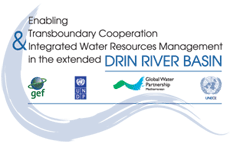Lake Ohrid Watershed Management Plan
Read the Lake Ohrid Watershed Management Plan here 
Read the Lake Ohrid Watershed Management Plan summary here 
Read the Lake Ohrid Watershed Management Plan summary in the languages of Albania and Kosovo here
Read the Lake Ohrid Watershed Management Plan summary in the language of North Macedonian here 
Read the Lake Ohrid Watershed Management Plan brochure here
Lake Ohrid, a UNESCO World Heritage site, is shared between Albania and North Macedonia and is one of Europe’s oldest and deepest lakes and a biodiversity hotspot of global importance. Being 2-5 million years old, it contains 55.4 km3 of water, hosts more than 300 endemic species and has 9 protected and sensitive areas. Approximately 170.000 people live around the lake, which sustains economic activities such as fishing, agriculture, hydropower and tourism.
The Lake faces a number of environmental challenges, all of which are exacerbated by climate change. As a result, the lake’s ecosystem and vulnerable biodiversity are threatened, as are the economic and human activities it hosts. In order to address these challenges, coordinated action is required at the national and transboundary levels.
Table: Environmental Challenges
|
Poor water status |
Construction of tourism facilities directly on the shore, destruction of reed belts (for agricultural land conversion and high pollution discharges at the mouth of the tributaries, have caused 75% of the water in the perimeter of the lake to have moderate, poor or bad status. |
|
Eutrophication |
Increased pollution from households, agriculture and industry results in decreased oxygen levels in parts of the lake during certain time periods, affecting in an adverse way the ecosystems. |
|
Habitat destruction |
Land development has impacted natural habitats along the shoreline. The connections between the lake and shoreline channels and wetlands have been interrupted, affecting endemic bottom fauna species, as well as water birds. |
|
Declining fish stocks |
Human activities along the shoreline threaten the spawning and wintering grounds of the Ohrid trout and other endemic fishes. Populations of commercially important fish as the Lake Ohrid trout and the belvica are in immediate danger of collapse, according to the IUCN List of Endangered Species. |
Under the GEF Drin Project, the Global Water Partnership – Mediterranean, in close cooperation with competent institutions in Albania and North Macedonia, developed the Lake Ohrid Management Plan (LOWMP).
The LOWMP, the result of scientific work-see above-with input by the stakeholders, was aimed to enable the sustainable management of Lake Ohrid’s natural resources. Its Programme of Measures included more than 100 measures designed to prevent further deterioration of water resources and ecosystems, promote sustainable water use, improve water resource and ecosystem quality and contribute to the mitigation of floods and droughts in the area.
It was prepared to be the official instrument of cooperation and act as the “Master Plan” for the two littoral countries. The LOWMP is only the second transboundary management plan developed in South East Europe in accordance with the European Union Water Framework Directive.
The development of the LOWMP was informed by data gathering, including a joint Lake Ohrid water quality surveillance monitoring campaign (a first of its kind to cover the total of the lake basin), an economic analysis and a valuation of ecosystem services.
A two-year consultation process took place, being of key importance for the development of the Management Plan. The process engaged all relevant stakeholders and institutions in Albania and North Macedonia, and comprised direct meetings with local government officials and businesses, focus group and expert group meetings as well as national consultation meetings in both countries.
The Lake Ohrid Watershed Management Plan was discussed by the bilateral Lake Ohrid Watershed Committee. The plan was approved by the responsible authorities of Albania and North Macedonia.





